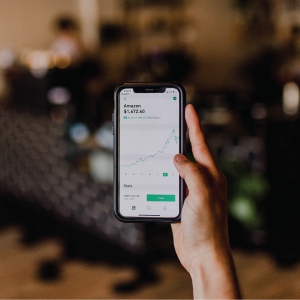
As a Financial Advisor, I can’t usually make any promises. But there is one thing about this industry that remains true: technology in finance and investing is ALWAYS changing.
Recently — as I looked at old family pictures — I remembered that I spent most of my summer days as a child with my grandparents. I found a picture of my grandmother and I; she was holding my hand, her purse was on her wrist and her little stock notebook was in her other hand. The memories came back about how I first became interested in my career at a young age. My grandmother would pack myself (and my brother) up and we would go to her “stockbroker’s” office. We would wait while she watched the electronic ticker tape scroll by, looking for a stock quote. She then noted the price in her little notebook.
My grandmother thought the digital ticker was amazing. When she first started investing, investors of the time had to watch a paper ticker tape. In my grandmother’s world, the paper ticker tape had just been replaced by the digital ticker, in 1970 (though larger brokerage firms in larger cities probably stopped using paper tickers in the 1960s).
Allen & Co. and LPL are committed to technological innovation
My, how technology has evolved since then (feels like an understatement!)
Once of the reasons we are so excited about our affiliation with LPL is that together, we are committed to innovating in this area. LPL expects to spend $135 million towards technology in 2019. Technology allows financial advisors and investors to make faster and more educated decisions.
 In the “old” days, investors relied on other people’s recommendations and research. Now, it’s easy to find company reports that are in-depth, with more and more companies providing real timedata. As an advisor, I can quickly give my clients a wealth of information and track performance easily.
In the “old” days, investors relied on other people’s recommendations and research. Now, it’s easy to find company reports that are in-depth, with more and more companies providing real timedata. As an advisor, I can quickly give my clients a wealth of information and track performance easily.
The result? Investors today feel more informed — and usually, their reaction time is much faster. As opposed, of course, to when investors relied on newspapers, then had to go down to their broker’s office to watch the ticker tape, then wait for their broker to write a ticket, then wait for traders on the floor to yell at each other to get the trade finalized! Today, computer systems buy and sell stocks and bonds almost instantaneously.
Technology has created more volatile markets
As such, everything may be easier in terms of getting information and facilitating trading. But how has all this automation and technological innovation changed the way we look at — and think about — the markets? Has this technology changed the markets as a whole?
This almost immediate ability to trade in and out of stocks and bonds, research, and automate has led to more volatility in the markets. Basically, it’s just too easy. I tell my clients to stop hallucinating and believing that one can time the markets, no matter how powerful the tools at our disposal may be.
I tell my clients to:
- Focus on the things that you can control.
- Follow a disciplined approach.
- Make sure you are asset allocated according to your time frame and risk tolerance.
Take advantage of the “new world” of volatility
 Not all investments will rise and fall together in this new world of volatility. Accept that if your risk tolerance is low, your return might also be low. Don’t try to turn around and blame politics or the news or anyone else for the “lower-than-the S&P 500-Index” returns that you receive. Dollar cost average into the market, in your retirement plans especially.
Not all investments will rise and fall together in this new world of volatility. Accept that if your risk tolerance is low, your return might also be low. Don’t try to turn around and blame politics or the news or anyone else for the “lower-than-the S&P 500-Index” returns that you receive. Dollar cost average into the market, in your retirement plans especially.
Instead, let technology and its side effect (market volatility) work for you and not against you. Stay tuned next month for part 2 — when I discuss not only how technology has changed the face of investing… but how it has changed financial planning as a whole.
July 2019
Content in this material is for general information only and not intended to provide specific advice or recommendations for any individual. No strategy assures success or protects against loss. Investing involves risk including loss of principal. Dollar cost averaging involves continuous investment in securities regardless of fluctuation in price levels of such securities. An investor should consider their ability to continue purchasing through fluctuating price levels.
